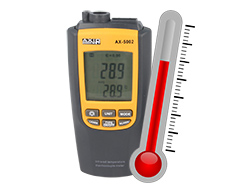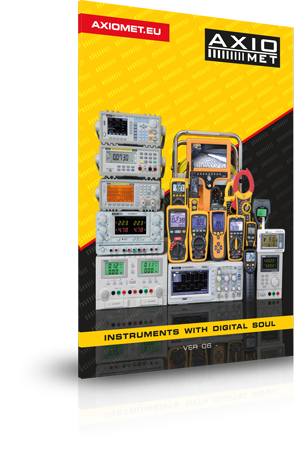Temperature measurement uncertainty depending on resolution and error of a thermometer
Temperature measurement accuracy is a difference, specified with a finite accuracy, between an actual value and a measured value.
 Due to the fact that an actual value is unknown, it is possible to determine, with some probability, a range within which it is included. Therefore, temperature measurement accuracy is determined by a value of uncertainty of this result. There are numerous documents with established standards which define requirements and appropriate course of action in case of expressing uncertainty. Definition and method for uncertainty calculation are described in the following document: “Evaluation of measurement data — Guide to the expression of uncertainty in measurement”; JCGM 100:2008 (with further supplements).
Due to the fact that an actual value is unknown, it is possible to determine, with some probability, a range within which it is included. Therefore, temperature measurement accuracy is determined by a value of uncertainty of this result. There are numerous documents with established standards which define requirements and appropriate course of action in case of expressing uncertainty. Definition and method for uncertainty calculation are described in the following document: “Evaluation of measurement data — Guide to the expression of uncertainty in measurement”; JCGM 100:2008 (with further supplements).
Boundary and total errors
According to recommendations stipulated in the above-mentioned document, notions of an error and uncertainty are used to describe the accuracy of measuring equipment only.
In case of all thermometers, accuracy is connected with a boundary error specified in technical documentation:
- a relative boundary error of a thermometer is expressed as a percentage, e.g. δT = ±1%,
- an absolute boundary error is expressed as a temperature range, e.g. ΔT = ±1°C.
A total error, depending on the design and accuracy of a thermometer, may be:
- a measured value error,
- a measuring range error,
- a measured value and measuring range error,
- a measured value error + additional error,
- a measured value + resolution error.
Thermometer resolution
Resolution is, alongside a boundary error, a key parameter of thermometers.
A value of resolution is the smallest increment of temperature that can easily be measured with the use of a particular thermometer.
For example, a temperature of 23.5°C shown on a digital thermometer display is measured with a resolution of 0.1°C. It does not mean, however, that measurement accuracy is of the same value. In case of thermometers with very small resolution, a resolution value may be close to a boundary error value of a thermometer. In case of precise measuring devices, a resolution value is always considerably lower than a boundary error value.
In practice, an error resulting from a finite resolution of a thermometer constitutes an element of a boundary error.
Temperature measurement uncertainty
Error of a thermometer and measurement accuracy are closely linked, however, they have different numeric values.
When we know a total error of a thermometer and determine measurement uncertainty value, we will be able to determine temperature measurement accuracy.
*All types of measuring device errors influence measurement uncertainty value:
- a total error of a thermometer,
- a total error of a temperature converter,
- a total error of a temperature sensor,
- manufacturing tolerance of a sensor,
- any additional errors that can be identified and expressed as numerical values.
While determining measurement uncertainty, all other sources of uncertainty, that can be expressed by numbers, should be taken into account, e.g.:
- measurement scattering,
- parametric instability,
- accuracy of numerical calculations,
- accuracy of calculation constants
- and other.
Guidelines on measurement accuracy
In the following list you will find legal documents, standards and recommendations related to temperature measurement accuracy:
- Evaluation of measurement data — Guide to the expression of uncertainty in measurement; JCGM 100:2008 (with further supplements);
- ISO/IEC Guide 99:2010. International Vocabulary of Basic and General Terms in Metrology (VIM);
- EN ISO/IEC 17025. General requirements for the competence of testing and calibration laboratories;
- EN ISO/IEC 10012. Measurement management systems — Requirements for measurement processes and measuring equipment;
- PISO 5725. Accuracy (trueness and precision) of measurement methods and results;
- EN 13486. Temperature Recorders and Thermometers for the Transport, Storage and Distribution of Chilled, Frozen, Deep-frozen/quick-frozen Food and Ice cream — research, requirements, application;
- EN 60584. Thermocouples; this standard defines characteristics, metrological parameters and accessories for thermoelectric thermometers;
- EN 60751. Platinum temperature sensors of industrial resistance thermometers and platinum temperature sensors; this standard defines physical characteristics, metrological and fixed parameters of platinum resistance thermometers.
Summary
A boundary error and resolution characterize a temperature measuring device. Their value depends on measurement methods, temperature sensors, converters and measuring systems used in thermometers. If we want to specify accuracy of a measurement, it is necessary to determine a temperature measurement uncertainty value.













